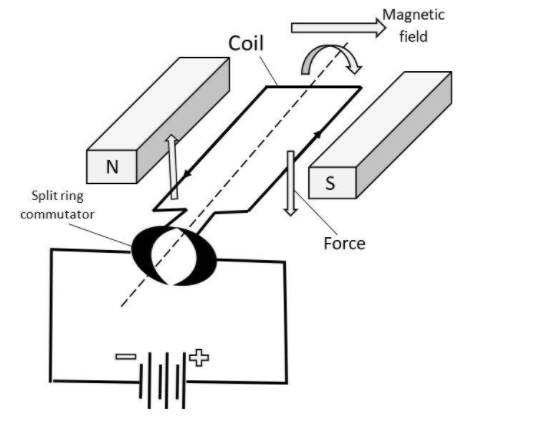
On what principle electric motor works?
A. Principle of force experienced by current carrying conductor in magnetic field
B. Principle of current experienced by current carrying conductor in magnetic field
C. Principle of force experienced by current carrying conductor in electric field
D. None of the above
Answer
537k+ views
Hint: The electric motor is an electrical device which is capable of converting electrical energy into mechanical energy by using the magnetic effect of electric current. In an electric motor, we place a current-carrying-conductor in a magnetic field which experiences a force.
Complete step by step answer:
An electric motor is an electrical device which is used for converting electrical energy into mechanical energy (usually a torque). This conversion is obtained through the generation of a magnetic field.
When a current-carrying conductor is placed in a magnetic field, it experiences a force.
The experiment shows that the magnitude of the force depends directly on the current in the wire, and the strength of the magnetic field. The force is greatest when the magnetic field is perpendicular to the conductor.

So, an electric motor is based on the principle of ‘force experienced by a current carrying conductor in a magnetic field’.
Hence, the correct option is A, i.e., Principle of force experienced by the current carrying conductor in the magnetic field.
Additional Information:
When an electric current is passed through a rectangular coil, this current produces a magnetic field around the coil. Thereafter the magnetic field of the magnet interacts with the magnetic field of the coil and causes the coil to rotate continuously.
Note: The students should understand that the working of the electric motor is purely based on the Faraday’s law of electromagnetic induction where the magnetic effect of electric current is involved. The law states that the changing fields produce electromotive force or emf.
Complete step by step answer:
An electric motor is an electrical device which is used for converting electrical energy into mechanical energy (usually a torque). This conversion is obtained through the generation of a magnetic field.
When a current-carrying conductor is placed in a magnetic field, it experiences a force.
The experiment shows that the magnitude of the force depends directly on the current in the wire, and the strength of the magnetic field. The force is greatest when the magnetic field is perpendicular to the conductor.

So, an electric motor is based on the principle of ‘force experienced by a current carrying conductor in a magnetic field’.
Hence, the correct option is A, i.e., Principle of force experienced by the current carrying conductor in the magnetic field.
Additional Information:
When an electric current is passed through a rectangular coil, this current produces a magnetic field around the coil. Thereafter the magnetic field of the magnet interacts with the magnetic field of the coil and causes the coil to rotate continuously.
Note: The students should understand that the working of the electric motor is purely based on the Faraday’s law of electromagnetic induction where the magnetic effect of electric current is involved. The law states that the changing fields produce electromotive force or emf.
Recently Updated Pages
NCERT Solutions For Class 12 Maths Three Dimensional Geometry Exercise 11.2

NCERT Solutions For Class 11 Maths Sets Exercise 1.4

NCERT Solutions For Class 11 Maths Miscellaneous Exercise - Limits and Derivatives

NCERT Solutions For Class 12 Maths Integrals Exercise 7.9

NCERT Solutions For Class 11 Biology In Hindi - Excretory Products And Their Elimination

NCERT Solutions For Class 2 Hindi Sarangi - Gire Taal Mein Chanda Maama

Trending doubts
Which are the Top 10 Largest Countries of the World?

Differentiate between homogeneous and heterogeneous class 12 chemistry CBSE

Why is the cell called the structural and functional class 12 biology CBSE

a Tabulate the differences in the characteristics of class 12 chemistry CBSE

Who discovered the cell and how class 12 biology CBSE

Draw a labelled sketch of the human eye class 12 physics CBSE




